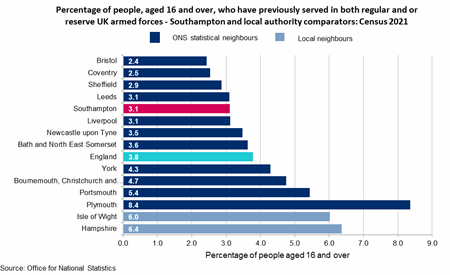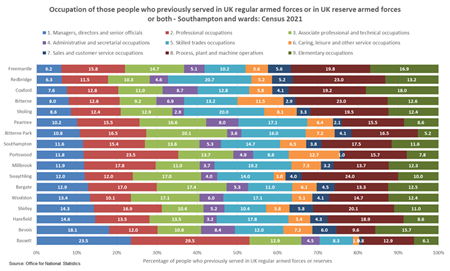
Veterans
Armed Forces Covenant and veterans overview
 The Armed Forces Covenant is a promise from the nation that those who serve or have served (veterans) in the British military and their families will not be disadvantaged by their service. The Armed Forces Covenant defines armed forces as Royal Navy, Royal Marines, Royal Air Force and Regular Army and associated Reservists. The armed forces community is defined as: anyone who is or has served for at least 1 day in the armed forces (regular or reserve, including national service) as well as Merchant Navy Seafarers and fishermen who have served in a vessel that was operated to facilitate military operations by the armed forces.
The Armed Forces Covenant is a promise from the nation that those who serve or have served (veterans) in the British military and their families will not be disadvantaged by their service. The Armed Forces Covenant defines armed forces as Royal Navy, Royal Marines, Royal Air Force and Regular Army and associated Reservists. The armed forces community is defined as: anyone who is or has served for at least 1 day in the armed forces (regular or reserve, including national service) as well as Merchant Navy Seafarers and fishermen who have served in a vessel that was operated to facilitate military operations by the armed forces.
The 2021 Census in England and Wales asked people if they had previously served in the UK armed forces. The question on UK armed forces veterans was added into the 2021 Census to better meet the needs for service providers and others who support veterans, in line with the Armed Forces Covenant ONS Census 2021. People aged 16 years and over were asked whether they had previously served in the regular or reserve UK armed forces, or both. People currently serving in the UK armed forces and those who had never served were both advised to tick "no".
The Census 2021 included information specifically on UK armed forces veterans, not on those currently serving. It identifies people who have previously served in the UK armed forces. This includes those who have served for at least one day in armed forces, either regular or reserves, or Merchant Mariners who have seen duty on legally defined military operations. This definition is similar to the one use in the Armed Forces Covenant.
The Census 2021 data tables can include responses to the question on having previously served as well as responses to other questions on age, sex, ethnicity, health and disability to profile the veterans population further, supporting local decision making as well as decisions under the Armed Forces Covenant. On this page, those people aged 16 and over who have ‘previously served in the UK armed forces or reserves’ are also referred to as veterans.
Locally the strategic direction for the Armed Forces Covenant is guided through the Solent Armed Forces Partnership Board (SAFPB), which includes Portsmouth, Southampton, Gosport and the Isle of Wight as signatories to the Covenant.
More information is available in the resources section at the bottom of the page.
Number of veterans
 The Census 2021 recorded 6,361 (3.1%) Southampton residents (aged 16 and over) who had previously served UK armed forces or reserves (veterans). Southampton’s percentage of veterans is lower when compared to England (3.8%) and the 5th lowest percentage amongst our ONS comparators which ranges from Plymouth with the highest (8.4%) to Bristol is the lowest (2.4%).
The Census 2021 recorded 6,361 (3.1%) Southampton residents (aged 16 and over) who had previously served UK armed forces or reserves (veterans). Southampton’s percentage of veterans is lower when compared to England (3.8%) and the 5th lowest percentage amongst our ONS comparators which ranges from Plymouth with the highest (8.4%) to Bristol is the lowest (2.4%).
The Census question allows you to look at how veterans had served (regular/reserves). Of the 6,361 Southampton residents who have previously served in the UK armed forces:
- 75.0% served only in the UK armed forces – lower than 76.3% in England
- 21.2% served only in the UK reserves – higher than 19.5% in England
- 3.9% had served in both the regular and the reserve armed forces – lower than 4.3% in England
The local authorities, with the highest proportion of veterans were key former or current armed forces communities; Gosport, a former major naval town (12.5%), North Kesteven; home of three current and one former RAF stations (10.2%) and Richmondshire (9.5%) including Catterick Garrison, the largest British Army garrison.
Looking closer to home at the variation across sub-city areas in Southampton, Harefield ward includes 4.5% people who are veterans, compared to Bevois with just 1.2% of people who previously served.
The Census data tells for those who have served, were they more likely to have been regular armed forces, reserves or having served in both. Additional analysis also shows where in the city these veterans who served in these different ways are living. Redbridge ward highest percentage of regular armed forces veterans of their veterans, 80.4% or 337 people, whilst Bevois had the highest percentage of UK armed forces reserves among their veterans, 31.7% but only 58 people. Of those veterans who previously served in both regular and reserve UK armed forces, the highest percentage was 6.3% of people in Shirley compared with 3.9% in Southampton.
More information is available in the data compendium in the resources section at the bottom of the page.
Age and sex of veterans
The breakdown by sex of veterans in Southampton showed 86.8% of people who previously served in the UK armed forces or in the reserves were male and 13.2% were females. This is similar to England where veteran breakdown is 86.5% for males and 13.5% for females. Ward level breakdowns are in the compendium, available in the resources section.
Veterans are more likely to be older people; 51.7% of veterans locally and 53.2% of veterans nationally are aged 65 and over. The range across the city shows 62.7% of veterans in Bassett who were aged 65 and over, higher compared to 36.2% in Bevois. Differences by sex reflects National Service legislation (1939 to 1960), showing in Southampton, 42.7% of female veterans and 53.1% of male veterans were aged 65 years. In England, this percentage is 40.5% of female veterans and 55.2% are males are aged 65 and over.
More information is available in the data compendium in the resources section at the bottom of the page.
Ethnicity of veterans
In Southampton, 92.2% of veterans were White British (higher when compared to 82.2% of the non-veteran population aged 16 and over in Southampton). Southampton is lower when compared nationally at 94.4% White British of veterans and the second lowest when compared to our ONS comparators, which ranges from the highest being Plymouth (97.4%) and Coventry being the lowest (88.6%).
Ward level breakdowns are in the compendium, available in the resources section, highlighting although low number, Bevois has a higher percentage of non-white veterans (14.2%) of than that for the city (4.6%).
More information is available in the data compendium in the resources section at the bottom of the page.
Health and disability
 The 2021 Census asked about general health, this is based on the question - How is your health in general? The data recorded those in good health or those in bad health. In Southampton, 35.9% of veterans, reported themselves to be in bad health higher when compared to 35.5% of veterans in England, but also far higher than 20.1% of the overall city population (aged 16 and over) reporting to be in bad health. This may be due to combat sustained injuries. Variation among Southampton wards ranges from 43.3% of veterans in both Coxford and Bitterne are not in good health to Bargate (30.7%).
The 2021 Census asked about general health, this is based on the question - How is your health in general? The data recorded those in good health or those in bad health. In Southampton, 35.9% of veterans, reported themselves to be in bad health higher when compared to 35.5% of veterans in England, but also far higher than 20.1% of the overall city population (aged 16 and over) reporting to be in bad health. This may be due to combat sustained injuries. Variation among Southampton wards ranges from 43.3% of veterans in both Coxford and Bitterne are not in good health to Bargate (30.7%).
Three out of ten veterans (31.4%) are disabled under the Equality Act and of those 48.4% of people who served had their day-to-day activities limited a lot and 51.6% reported having their day-to-day activities limited a little. This compares to two out of ten (19.8%) for Southampton’s general population who are disabled under the Equality Act - with 39.8% of all Southampton residents aged 16 and over had their day-to-day activities limited a lot and 60.2% limited a little.
In Bargate wards 55.8% of veterans reported their day-to-day activities limited a lot, this was the highest among wards and the lowest was Bevois with 37.7%.
Data is not currently available, from the 2021 Census, on the types of illness or disability that veterans may have, more detail is due to be released later in 2023 and in 2024. Information from PTSD UK suggests that the estimated rate of PTSD among UK veterans of all conflicts is 7.4%. The rate for PTSD among the public is 4%. Using this rate (7.4% of 6,361 veterans), would suggest that there are 470 veterans have PTSD in Southampton.
The University Hospital Southampton NHS Foundation Trust is one of 104 NHS providers that are accredited to have the best care for veterans, to help care for people that serve or have served in the UK armed forces and families. These Veteran Aware trusts are helping to provide and improve veterans’ care, as part of the Veterans Covenant Healthcare Alliance (VCHA).
More information is available in the data compendium in the resources section at the bottom of the page.
Employment
The 2021 Census asked a number of questions related to work, including whether the person had worked in the last seven days, what their employment status was. The data on employment may have been affected by the Census being conducted during the COVID-19 pandemic where many people may have been furloughed from their normal job. The guidance, from the ONS, suggested people who had been furloughed should complete the work related questions as "temporarily away from work". This would ensure they were included in the economically active population.
More information is available from the Office for National Statistics – Labour market quality information for Census 2021.
In Southampton, among the veteran community 34.2% were employees, 6.8% were self-employed and 1.9% were unemployed but could start work- a lower percentage when compared with employees percentage for the whole working population of Southampton (46.6%) and nationally (46.2%).
More than half (56.2%) of Southampton veterans are economically inactive, including 48.0% who are retired, 3.6% who are long term sick or disabled and 1.1% who ae looking after home or family. Compared with 38.1% of the aged 16 and over population who are economically inactive, of which 15.5% are retired, 4.2% who are long term sick or disabled and 4.7% who are looking after home or family. Nationally 39.1% were economically inactive, 21.5% were retired, 4.1% who are long term sick or disabled and 4.8% who are looking after home or family.
More information is available in the data compendium in the resources section at the bottom of the page.
Occupation
 The three most common occupation groups for Southampton working age veterans are:
The three most common occupation groups for Southampton working age veterans are:
- 17.5% in process, plant and machine operative occupations, (higher compared to 8.7% for the city workers and 7.0% workers nationally)
- 15.4% worked in professional occupations (lower compared to 19.8% for the city workers and 20.2% workers nationally)
- and 14.7% worked in skilled trades occupations (higher compared to 10.3% for the city workers and 10.3% workers nationally)
Among Southampton’s wards, 24.0% of working age veterans, in Swaythling work in process, plant and machine operative occupations, this may be related to working in the Wide Industrial areas including Southampton Airport itself. In Redbridge 23.0% work in process, plant and machine operative occupations, an area that has easy access to Southampton docks, compared with just 9.6% in Bevois. In Bassett 23.5% work in professional occupations, compared with 10.1% in Woolston. In Redbridge 20.7% work in skilled trade occupations compared with 8.3% in Bassett.
More information is available in the data compendium in the resources section at the bottom of the page.
Households
In Southampton, 5.9% (6,013) of households contained 1 or more people who had previously served in the UK armed forces, of these 5.7% were 1 person in the household, 0.2% were 2 people in the household and only 9 households (0.02%) with 3 or more people in the household who served. Amongst our comparators the highest number of households is Plymouth with 14.8% of households has 1 or more people who had previously served in UK armed forces and the lowest is Bristol with just 4.7%. Nationally 7.0% of households has 1 or more people who had previously served in UK armed forces.
Among Southampton wards, 8.0% of households have one or more people who previously served in UK armed forces, compared with 2.4% in Bevois.
More information is available in the data compendium in the resources section at the bottom of the page.
Resources
Census 2021 interactive dashboard
Users can access a range of Census data across different topic areas including population, education, identity, housing, health and work. With the ability to view benchmarking between Southampton and ONS comparators and mapping of data by Census geographies, such as lower layer super output areas (LSOA) a neighbourhood of around 1,500 residents.
Census 2021: Veteran data compendium
More information on veterans from the Census 2021 data tables including responses to the question on having previously served as well as responses to other questions on age, sex, ethnicity, health and disability to profile the veterans population further.
Solent Armed Forces Partnership Board (SAFPB) - Solent Armed Forces Covenant needs assessment
The Armed Forces Covenant is a promise from the nation that those who serve or have served in the British military and their families will not be disadvantaged by their service. Portsmouth, Southampton, Gosport and the Isle of Wight are signatories to the Covenant and in 2016 these local authorities came together to form the Solent Armed Forces Partnership Board (SAFPB). This report provides strategic governance for local delivery within the region.
Portsmouth City Council
ONS - Characteristics of UK armed forces veterans, England and Wales: Census 2021
UK armed forces veterans population who have either previously served in the regular forces, reserve forces or both, Census 2021 data.
UK Government
Cabinet Office - Office for Veteran’s Affairs
NHS resources
Healthcare for the armed forces community - How the NHS can help the British armed forces or veterans, reservists or family members of someone who is serving or who has served. Veterans Covenant Healthcare Alliance (VCHA) Work with NHS providers and commissioners and the independent healthcare sector, including hospices, care homes, residential homes to improve care for the armed forces community through the awarding of Veteran Aware accreditation.
PTSD UK - Causes of PTSD: Military personnel and Veterans experiences
Office of Veteran's Affairs and Ministry of Defence - 10 things to know about veterans and their families
Ten introductory facts and key points about the veteran community to help you better understand veterans and their families.
Last updated: 30 June 2023